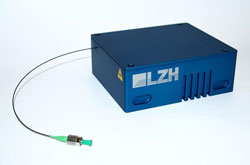Laser Technology from Lower Saxony Goes West

A compact, mode-coupled fiber oscillators for structuring organic solar cells<br>
The end of January is Photonics West time! Over 1150 exhibitors have registered for the most important US American photonics exhibition in the Moscone Center, San Francisco (CA). The Laser Zentrum Hannover e.V. (LZH) will also be there to present current innovations from the Laser Development Department to the 19000 international visitors expected to attend the exhibition.
Simplified Production Processes for Microprocessing of Plastics
The Ultrafast Photonics Group is following new concepts for compact, mode-coupled fiber oscillators for structuring organic solar cells. This newest development will be shown to the public in the USA – a fully fiber-based ultrashort-pulsed thulium oscillator emitting at a wavelength of 1.98 µm. This systems works in the range of dissipative solitons with characteristically high pulse energies of 2 nJ (nanojoules) and repetition rates of 10 MHz, also with high quality chirped pulses with a pulse length of several tens of picoseconds. Mode coupling takes place using fiber-coupled, saturable absorber mirrors.
The oscillator serves as a seed source for fiber amplifiers working at a wavelength of 2 µm. This system, in turn, pumps a non-linear conversion step, generating radiation between 3 and 8 µm. The whole system, which is being realized within the framework of the EU project IMPROV (www.fp7project-improv.eu), will not only simplify the production of organic solar cells for use in photovoltaics, but also organic light-emitting diodes (OLED) and organic thin-film transistors (OTFT) with decidedly lower area losses.
Searching for Traces using pulsed, high-energy Lasers
The Space Technologies Group (SPT) is developing a diode-pumped, solid-state laser especially designed for use in outer space. Currently, a laser prototype for the planned ESA and NASA ExoMars joint mission is being further developed into a full-fledged flight model. The laser is one of the main elements of the ‘Mars Organic Molecule Analyzer’, called MOMA for short. Working with an emission wavelength of 266 nm and a laser pulse output of 250 µJ, this unit will be used to analyze organic material by means of Laser Desorption Mass Spectrometry (LD-MS), one of the methods that can be used to find traces of life on Mars. In order to be suitable for use in outer space, the scientists have given the laser a hermetic housing, using radiation resistant and low-emission materials, as well as providing components with special optical coatings. The laser runs with high repetition bursts of up to 100 Hz. The near-flight prototype, which has already passed vibration tests of up to 20 times gravitational acceleration, can be seen at the exhibition.
The second exhibit of the Space Technologies Group is a robust laser head that weighs only 35 g, for use in analyzing the distribution of elements on the surface of planets, or for analyzing materials on the earth, under extremely rough environmental conditions. The LIBS laser system is fitted with highly specialized electronic elements and works at the wavelength 1053 nm, with a pulse energy of > 1 mJ and a pulse repetition rate
High Output Fiber Components for the NIR Range
Various new developments are being shown by the Fiber Optics Group, for fiber integration of the continual and pulsed emitting laser sources in the wavelength range between 1 and 2 µm. Two pump and signal couplers are used, each with lateral overcoupling, so they can also be used for back-pumped units. However, harmful signals cannot enter the pump fibers, which could lead to destruction of the pump diodes. A coupler combines the pump wavelength of 795 nm with a signal wavelength of 2 µm, and can be used in thulium fiber lasers. The second was optimized for the wavelength range of 1 µm, and can couple 4 different laser diodes, each with a record output of 100 W, into a signal fiber.
The new monomode wavelength multiplexer for 1025/1064 nm has a specified output stability of over 26 W per channel, a value twice as high as other components currently available on the market. Using this unit, core-pumped set-ups with the highest outputs in the wavelength range around 1 µm are possible.
The LZH is in the north hall, on the most prominent collective German stand, with 418 m² and a total of 54 exhibitors.
We hope you visit us at the German Pavilion/ Stand 4601-23!
Contact:
Laser Zentrum Hannover e.V.
Michael Botts
Hollerithallee 8
D-30419 Hannover
Germany
Tel.: +49 511 2788-151
Fax: +49 511 2788-100
E-Mail: m.botts@lzh.de
http://www.lzh.de
The Laser Zentrum Hannover e.V. (LZH) carries out research and development in the field of laser technology and is supported by the Ministry of Economic Affairs, Labour and Transport of the State of Lower Saxony (Niedersächsisches Ministerium für Wirtschaft, Arbeit und Verkehr).
Media Contact
More Information:
http://www.lzh.deAll latest news from the category: Trade Fair News
Newest articles

Innovative 3D printed scaffolds offer new hope for bone healing
Researchers at the Institute for Bioengineering of Catalonia have developed novel 3D printed PLA-CaP scaffolds that promote blood vessel formation, ensuring better healing and regeneration of bone tissue. Bone is…

The surprising role of gut infection in Alzheimer’s disease
ASU- and Banner Alzheimer’s Institute-led study implicates link between a common virus and the disease, which travels from the gut to the brain and may be a target for antiviral…

Molecular gardening: New enzymes discovered for protein modification pruning
How deubiquitinases USP53 and USP54 cleave long polyubiquitin chains and how the former is linked to liver disease in children. Deubiquitinases (DUBs) are enzymes used by cells to trim protein…



